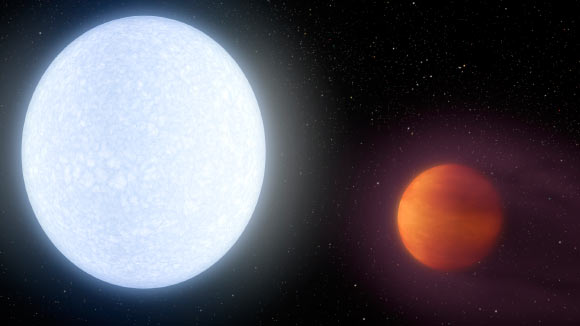A newly-discovered Jupiter-like exoplanet called KELT-9b is only 2,000 degrees Fahrenheit (927 degrees Celsius, or 1,200 degrees Kelvin) cooler than our Sun.

Artist’s illustration of the star KELT-9 (left) and its planet KELT-9b (right). The planet takes only 1.5 days to complete a revolution around its host star. Image credit: NASA / JPL-Caltech / Robert Hurt.
KELT-9b is a gas giant 2.8 times more massive than Jupiter but only half as dense.
The planet runs a close orbit to KELT-9, the hottest, most massive and brightest star yet found to host a transiting giant planet.
At approximately 17,850 degrees Fahrenheit (9,900 degrees Celsius, or 10,170 degrees Kelvin), the host star is at the dividing line between stars of type A and B.
Also known as HD 195689, the star is about 650 light-years away in the constellation Cygnus.
Another unique aspect to KELT-9b — the planet orbits the poles of KELT-9 rather than its equator.
“It’s unclear how KELT-9b obtained its peculiar orbit. In addition to being ridiculously close, the planet orbits about the poles of its parent star rather than its equator. One can only imagine how it got there,” said Justin Crepp, Freimann assistant professor of physics at the University of Notre Dame.
Because KELT-9b is tidally locked to KELT-9 — as the Moon is to Earth — the day side of the planet is perpetually bombarded by stellar radiation, and as a result is so hot that molecules such as water, carbon dioxide and methane can’t form there.
With a day-side temperature peaking at 7,820 degrees Fahrenheit (4,327 degrees Celsius, or 4,600 degrees Kelvin), KELT-9b is hotter than most stars.
The properties of the night side are still mysterious — molecules may be able to form there, but probably only temporarily.
Though KELT-9b is larger than Jupiter, it is not as dense. Prof. Crepp and his colleagues believe low surface gravity combined with its extremely high temperature contributes to an inflated and gaseous atmosphere.
UV radiation from KELT-9 is so brutal that the planet may be literally evaporating away under the intense glare, producing a glowing gas tail.
“KELT-9 radiates so much UV radiation that it may completely evaporate the planet,” said Keivan Stassun, professor of physics and astronomy at Vanderbilt University.
“Or, if gas giant planets like KELT-9b possess solid rocky cores as some theories suggest, the planet may be boiled down to a barren rock, like Mercury.”
“That is, if the star doesn’t grow to engulf it first. KELT-9 will swell to become a red giant star in about a billion years,” Prof. Stassun said.
“The long-term prospects for life, or real estate for that matter, on KELT-9b are not looking good.”
A paper reporting this discovery is published in the journal Nature.
_____
B. Scott Gaudi et al. A giant planet undergoing extreme-ultraviolet irradiation by its hot massive-star host. Nature, published online June 5, 2017; doi: 10.1038/nature22392







